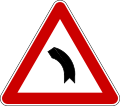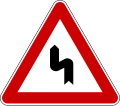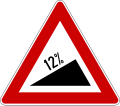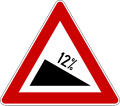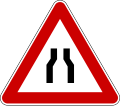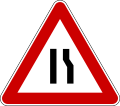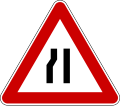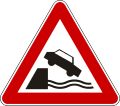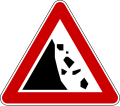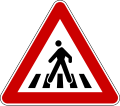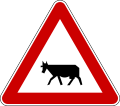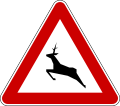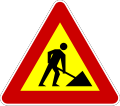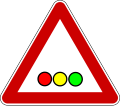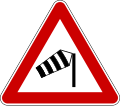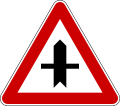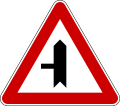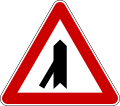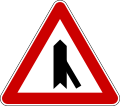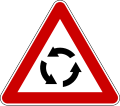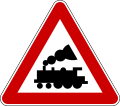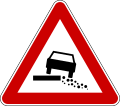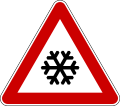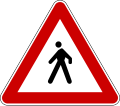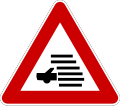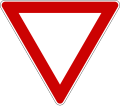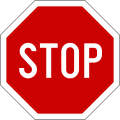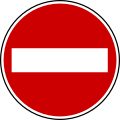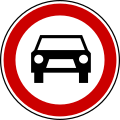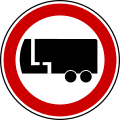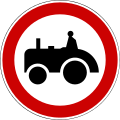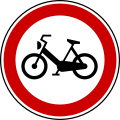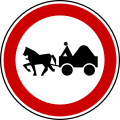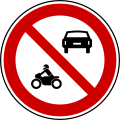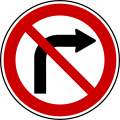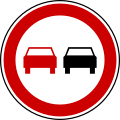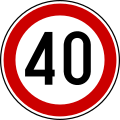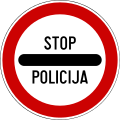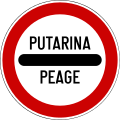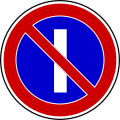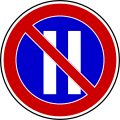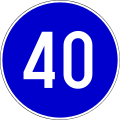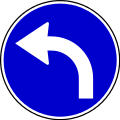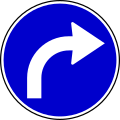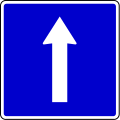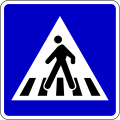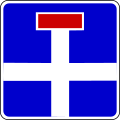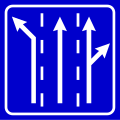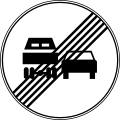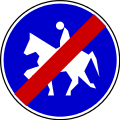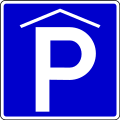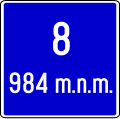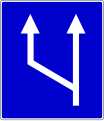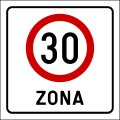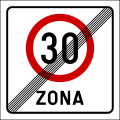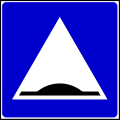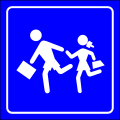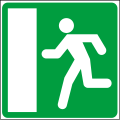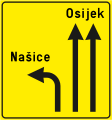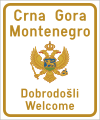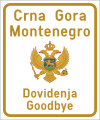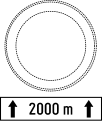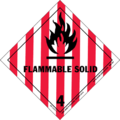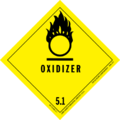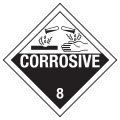Road signs in Montenegro
Road signs in Montenegro are regulated in Pravilnik o saobraćajnoj signalizaciji.[1]
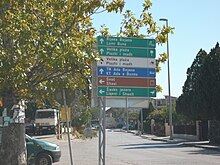
The road signs in Montenegro follow the 1968 Vienna Convention on Road Signs and Signals, and the former Yugoslav standard road signs, used by the successor states of SFR Yugoslavia. Since Serbia and Montenegro were one state from 1992 to 2006 after the breakup of Yugoslavia, road signs in Montenegro are mostly similar to Serbian ones, except that the inscriptions are only written in Latin script. Following Montenegro's declaration of independence in 2006, the country's own road sign standard was adopted. With the adoption of the Constitution of Montenegro in 2007, in which the newly formed Montenegrin was promoted as an "official language", all public inscriptions, including road signs, began to be written in Latin script.[2] Despite the equality of the Cyrillic and Latin alphabets in Montenegro, as stated in the country’s Constitution, inscriptions on road signs are written exclusively in Latin script.
The SNV typeface is used on Montenegrin road signs as well as in other former Yugoslav states, Bulgaria and Romania. In Switzerland, the SNV typeface was also used on road signs before being replaced with the ASTRA-Frutiger typeface in 2003.
The former Yugoslavia had originally signed the Vienna Convention on Road Signs and Signals on November 8, 1968 and ratified it on June 6, 1977.[3] Yugoslavia formerly used a yellow background on warning signs. After Montenegro declared its independence, the country succeeded to the Vienna Convention on October 23, 2006.
Warning signs
[edit]Warning signs (Serbo-Croatian: Znakovi opasnosti) are used to warn road users of the danger that threatens them in a certain place, or part of the road, and to inform them about the nature of that danger. Warning signs are predominantly red and white in color.
-
I-1
Left curve -
I-1.1
Right curve -
I-2
Double curve, first at left -
I-2.1
Double curve, first at right -
I-2.2
Series of dangerous twists -
I-3
Steep uphill -
I-4
Steep downhill -
I-5
Road narrows -
I-5.1
Road narrows on left -
I-5.2
Road narrows on right -
I-6
Mobile bridge -
I-7
Quayside -
I-8
Bumpy road -
I-9
Potholes -
I-10
Traffic-calming bumps -
I-11
Slippery roads -
I-12
Loose chippings -
I-13
Rockfall -
I-13.1
Rockfall -
I-14
Pedestrian crossing -
I-15
Children area -
I-16
Cyclists crossing -
I-17
Domestic animal crossing -
I-18
Wild animal crossing -
I-19
Roadworks -
I-20
Vertical traffic light -
I-20.1
Horizontal traffic light -
I-21
Low-flying aircraft -
I-22
Crosswinds from left -
I-22.1
Crosswinds from right -
I-23
Bidirectional road traffic -
I-24
Tunnel -
I-25
Other hazards -
I-26
Intersection with right-priority rule -
I-27
Intersection on a priority road with a non-priority road -
I-28
Intersection on a priority road with a non-priority road from left -
I-28.1
Intersection on a priority road with a non-priority road from right -
I-29
Merging traffic from left -
I-29.1
Merging traffic from right -
I-30
Roundabout -
I-31
Tram crossing -
I-32
Gated level crossing -
I-33
Non-gated level crossing -
I-34
Crossbuck -
I-34.1
Crossbuck -
I-35
Distance-panels for gated level crossing -
I-36
Distance-panels for non-gated level crossing -
I-37
Dangerous shoulder -
I-38
Traffic queues likely -
I-39
Ice on road -
I-40
Accident -
I-41
Pedestrians on the road -
I-42
Fire danger -
I-43
Fog
Order signs
[edit]Order signs (Serbo-Croatian: Znakovi izričitih naredbi) inform road users of prohibitions, restrictions and obligations that must be adhered to. This category includes priority signs "Stop sign", "Give Way", "Yield to oncoming traffic", prohibitory and mandatory signs.
Prohibitory signs
[edit]Prohibitory signs (Serbo-Croatian: Znakovi zabrane i ograničenja) are used to prohibit certain types of manoeuvres or some types of traffic. Prohibitory signs are predominantly red and white in color.
-
II-1
Give way -
II-2
Stop -
II-3
Forbidden for road vehicles -
II-4
No entry -
II-5
Forbidden for motor vehicles, except solo motorcycles -
II-6
Forbidden for buses and coaches -
II-7
Forbidden for HGVs (lorries/trucks) -
II-8
Forbidden for water-pollutants -
II-9
Forbidden for explosive goods -
II-9.1
Forbidden for dangerous goods -
II-10
Forbidden for trailers -
II-10.1
Forbidden for articulated vehicles -
II-11
Forbidden for agricultural vehicles -
II-12
Forbidden for motorcycles -
II-13
Forbidden for mopeds -
II-14
Forbidden for bicycles -
II-15
Forbidden for electric scooters -
II-16
Forbidden for horsecarts -
II-17
Forbidden for human-powered vehicles -
II-18
Forbidden for pedestrians -
II-19
Forbidden for all motor vehicles -
II-19.1
Forbidden for motor vehicles, motorcycles, and horsecarts -
II-19.2
Forbidden for buses, coaches, agricultural machinery and horsecarts -
II-20
Width limit -
II-21
Height -
II-22
Maximum weight -
II-23
Maximum weight per axles -
II-24
Maximum length -
II-25
Safe distance -
II-26
No left turn -
II-26.1
No right turn -
II-27
No U-turn -
II-28
No overtaking -
II-29
No overtaking for HGVs and buses -
II-30
Speed limit -
II-31
Honking forbidden -
II-32
Customs -
II-32.1
Police -
II-32.2
Toll -
II-33
Yield to oncoming traffic -
II-34
No stopping -
II-35
No parking -
II-36
No parking on odd days -
II-36.1
No parking on even days
Mandatory signs
[edit]Mandatory signs (Serbo-Croatian: Znakovi obaveze) belong to the group of explicit command signs. Mandatory signs are predominantly blue in color with white symbols.
-
II-37
Minimum speed limit -
II-38
Snow chains mandatory -
II-39
Bike path -
II-40
Pedestrian path -
II-41
Pedestrian and bike path -
II-41.1
Pedestrian and bike path -
II-42
Trail for riders -
II-43
Proceed straight -
II-43.1
Turn right -
II-43.2
Turn left -
II-43.3
Turn left ahead -
II-43.4
Turn right ahead -
II-44
Proceed straight or turn left -
II-44.1
Proceed straight or turn right -
II-44.2
Turn left or right -
II-45
Pass onto right -
II-45.1
Pass onto left -
II-45.2
Pass either side -
II-46
Roundabout
Information signs
[edit]Information signs (Serbo-Croatian: Znakovi obavještenja) are placed in such a way that they provide traffic participants with advance notifications, notifications about realignment, notifications about turning, notifications about the direction of movement, as well as to mark the object, terrain, street or parts of the road to which they refer.
-
III-1
Priority over oncoming traffic -
III-2
One-way street -
III-2.1
One-way street -
III-3
Priority road -
III-4
End of priority road -
III-6
Pedestrian crossing -
III-8
Underground or overground pedestrian passage -
III-9
Dead end -
III-10
The road of movement of the vehicle to the intersection where it is forbidden to turn left -
III-11
Uses of lanes at an intersection -
III-12
End of overtaking prohibition -
III-13
End of overtaking by trucks prohibition -
III-14
End of speed limit -
III-15
End of minimum speed limit -
III-16
End of using horns prohibition -
III-17
End of snow chains mandatory -
III-18
End of bike path -
III-19
End of pedestrian path -
III-20
End of pedestrian and bike path -
III-20.1
End of pedestrian and bike path -
III-21
End of trail for riders -
III-22
End of previous prohibitions -
III-23
European route number -
III-24
Marker of the section of the county road -
III-25
Motorway -
III-26
End of motorway -
III-27
Expressway -
III-28
End of expressway -
III-29
Locality -
III-30
End of locality -
III-31
Built-up area -
III-32
End of built-up area -
III-33
No parking zone -
III-34
End of no parking zone -
III-35
Parking -
III-35.1
Parking garage -
III-36
Parking time limit -
III-36.1
Park and ride -
III-37
Hospital -
III-38
First aid -
III-39
Breakdown service -
III-40
Telephone -
III-41
Petrol station -
III-42
Hotel or motel -
III-43
Restaurant -
III-44
Cafe -
III-45
Park -
III-46
Camping for tents -
III-47
Camping for caravans -
III-48
Camping for tents and caravans -
III-49
Vila -
III-50
Road assistance -
III-51
Fire extinguisher -
III-52
Bus stop -
III-53
Tram stop -
III-54
Airport -
III-55
Port -
III-56
Information -
III-56.1
Radio station -
III-57
Taxi -
III-58
Toilet -
III-59
Passability of the road -
III-60
Serpentine number -
III-61
Road object -
III-62
Tunnel -
III-65
Police station -
III-66
Recommended speed limit -
III-67
Street sign -
III-68
Chevrons -
III-68.1
Chevrons -
III-68.2
Chevrons -
III-68.3
Chevrons -
III-69
Lane for buses -
III-70
End of lane for buses -
III-71
Beginning of traffic lane -
III-72
End of traffic lane -
III-73
Third lane -
III-74
End of third lane -
III-75
Emergency stopping lane -
III-77
Maximum speed limit on the roads in Montenegro -
III-78
Pedestrian zone -
III-79
End of pedestrian zone -
III-80
Speed limit zone -
III-81
End of speed limit zone -
III-82
Bump -
III-83
Children on the road -
III-84
Living street -
III-85
End of living street -
III-86
School zone -
III-87
End of school zone -
III-88
Alternating passing of vehicles -
III-89
Intermittent passing of vehicles -
III-93
Pay toll -
III-94
Toll collection facility -
III-95
Wrong way (Pogrešan smjer) -
III-96
Emergency exit -
III-96.1
Emergency exit -
III-97
Distance to the emergency exit -
III-97.1
Distance to the emergency exit
Information signs for traffic management
[edit]Information signs for traffic management (Serbo-Croatian: Znakovi obavještenja za vođenje saobraćaja) inform traffic participants about directions of movement, i.e. directions of movement along traffic lanes, to certain places.
-
III-201
An intersection -
III-201.1
A roundabout intersection -
III-202
Lane change with settlement directions -
III-203
Arrow signpost -
III-204
Distance to junction -
III-205
Direction confirmation -
III-207
Signpost for the exit -
III-210
Countdown beacon (100 m) -
III-210
Countdown beacon (200 m) -
III-210
Countdown beacon (300 m) -
III-211
Exit sign board (expressways) -
III-211.1
Exit sign board (motorways)
Tourist signs
[edit]Tourist signs (Serbo-Croatian: Znakovi turističke signalizacije) are intended to inform road users about tourist attractions and contents of the tourist offer within the tourist area or tourist destination.
Tourist signs indicate tourist destinations that are easily accessible to a wide range of users of tourist services, that have parking spaces and sanitary facilities, and that have organized reception and access for tourists with special needs.
-
III-401
Expression of welcome when entering the country -
III-401.1
Greeting when leaving the country -
III-402
Expression of welcome when entering the territory of the municipality -
III-408
Tourist direction sign
Additional signs
[edit]Additional signs (Serbo-Croatian: Dopunske table) are used in addition to warning, order and information signs. Additional signs specify the meaning of the traffic sign in more detail.
-
IV-1
Distance -
IV-2
Distance -
IV-3
Distance -
IV-3.1
Distance -
IV-4
Additional distance -
IV-4.1
Additional distance -
IV-5
Parking method -
IV-5.1
Parking method -
IV-5.2
Parking method -
IV-5.3
Parking method -
IV-5.4
Parking method -
IV-5.5
Parking method -
IV-5.6
Parking method -
IV-5.7
Parking method -
IV-5.8
Parking method -
IV-6
Priority road direction -
IV-6.1
Stop ahead -
IV-8
Side extension (of parking or stopping ban) -
IV-8.1
Side extension (of parking or stopping ban) -
IV-8.2
Side extension (of parking or stopping ban) -
IV-8.3
Start -
IV-8.4
Continue -
IV-8.5
End -
IV-9
Duration -
IV-10
Number of dangerous turns -
IV-11
Painting stripes on the road -
IV-12
Speed bump -
IV-13
Eldery people -
IV-14
Directions to parking -
IV-15
Road closed due to smog -
IV-16
Road conditions -
IV-16.1
Road conditions -
IV-16.2
Road conditions -
IV-17
Vehicle categories -
IV-18
Lateral distance -
IV-19
Parking place for handicapped persons -
IV-20
Limitation of the permitted maximum mass -
IV-21
Accident -
IV-22
Snowplow
Hazard-warning plates
[edit]-
Explosives
-
Flammable gas
-
Flammable liquid
-
Flammable solid
-
Oxidizer
-
Poisonous
-
Radioactive
-
Corrosive
-
Miscellaneous dangerous goods
See also
[edit]References
[edit]- ^ "Pravilnik o saobraćajnoj signalizaciji". Vlada Crne Gore (in Serbian). Retrieved 2023-02-26.
- ^ "U Crnoj Gori nema mesta za ćirilicu". B92.net (in Serbian). 2015-07-18. Retrieved 2023-09-18.
- ^ "United Nations Treaty Collection". treaties.un.org. Retrieved 2023-12-08.

